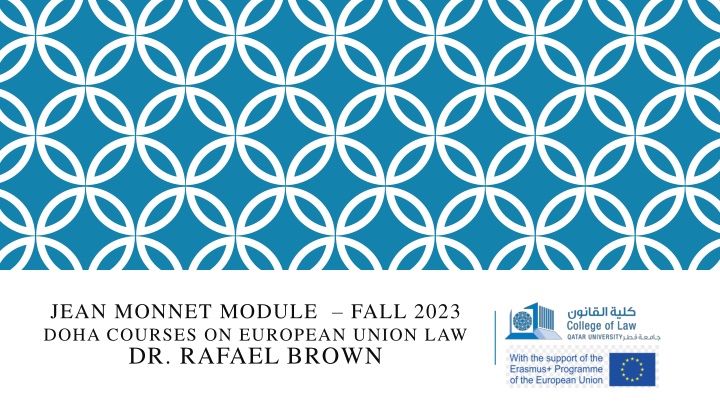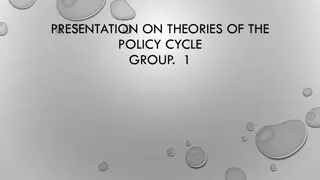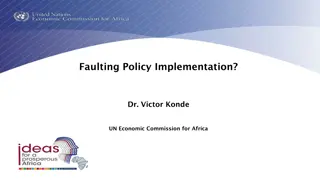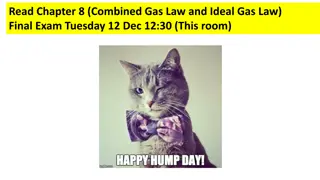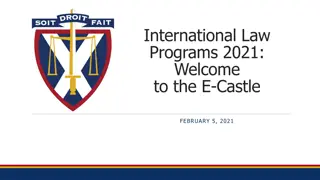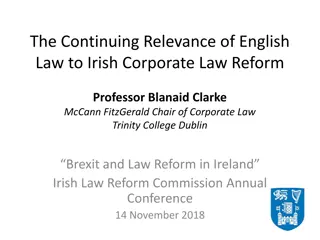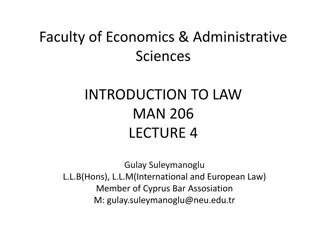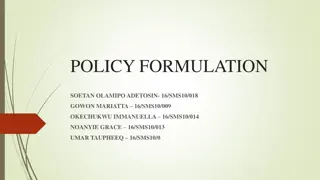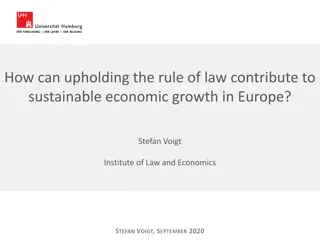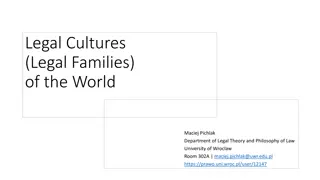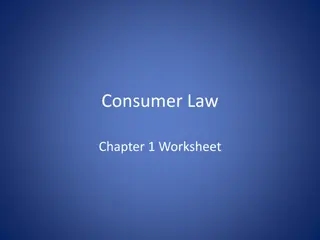EU Law & Policy Overview
In these courses, you will delve into European Union law under the guidance of Dr. Rafael Brown, covering topics such as EU environmental law, historical context, legal principles, and policy frameworks. Explore the agenda, introductions, and engaging discussions on EU member states, interests, and priorities. Join the discussion on the evolution of the EU from its inception to a union of multiple member states.
Download Presentation

Please find below an Image/Link to download the presentation.
The content on the website is provided AS IS for your information and personal use only. It may not be sold, licensed, or shared on other websites without obtaining consent from the author.If you encounter any issues during the download, it is possible that the publisher has removed the file from their server.
You are allowed to download the files provided on this website for personal or commercial use, subject to the condition that they are used lawfully. All files are the property of their respective owners.
The content on the website is provided AS IS for your information and personal use only. It may not be sold, licensed, or shared on other websites without obtaining consent from the author.
E N D
Presentation Transcript
JEAN MONNET MODULE FALL 2023 DOHA COURSES ON EUROPEAN UNION LAW DR. RAFAEL BROWN
EU ENVIRONMENTAL LAW AND POLICY Course 2, Module 1 Class 1 INTRODUCTION
AGENDA Introductions Historical Context Legal Basis Principles Policy Framework
WELCOME TO COURSE 2, MODULE 1 Convenor Dr. Rafael Dean Brown Clinical Associate Professor College of Law, Qatar University
INTRODUCTIONS ABOUT ME Teaching: Environmental Law and Regulation Working on: environmental impact of artificial intelligence like ChatGPT Scholarship: artificial intelligence, data protection, emerging tech, environmental law
INTRODUCTIONS ABOUT ME Education, Entrepreneurship, Travel
INTRODUCTIONS Who has visited a European Union (EU) country?
INTRODUCTIONS JM SCHOLARS COURSE 2 ABOUT YOU Environmental Science Sharia Engineering Professionals 17 College of Law 9 College of Business Law Arts & Science 8 College of Arts and Science 2 Legal Professionals/Graduates 1 College of Engineering 1 Environmental Science 1 College of Sharia Business
INTRODUCTION TO THE EU How many Member States are in the EU? Will they have the same interests and priorities?
EU HISTORICAL CONTEXT 1950 After WWII, 6 countries formed the European Coal and Steel Community (Belgium, France, Germany, Italy, Luxembourg and the Netherlands) 1957- Treaty of Rome (same 6) established the European Economic Community (ECC) to foster trade and economic integration (Treaty in the Functioning of the European Union) 1973 Denmark, UK, and Ireland joined ECC 1981 Greece joined ECC 1986 Portugal and Spain joined ECC 1993 ECC became the European Union (EU) under 1992 Treaty of Maastricht of 12 members 1995 Austria, Finland, Sweden joined the EU 2004 Czechia, Estonia, Hungary, Latvia, Lithuania, Poland, Slovakia, Slovenia, Cyprus and Malta joined the EU 2007 Bulgaria and Romania joined the EU 2013 Croatia joined the EU 2020 UK left the EU
REFLECTION TIME What initial observations can you make about the EU?
FORECASTING CHALLENGES What do you think would be the challenges the EU would face in creating and implementing laws (ie environmental laws)?
EU HISTORICAL CONTEXT 1993 Treaty of Maastricht created the European Union Also known as Treaty of European Union EU citizenship Single currency (Euro) Common foreign and security policy Created Three Pillars of EU (1993-2009): European Communities, Common Foreign and Security Policy, and Police and Judicial Cooperation in Criminal Matters
EU HISTORICAL CONTEXT 2009 Treaty of Lisbon reformed into Modern EU from unanimity to qualified majority voting in the Council of Ministers a change in calculating such a majority to a new double majority powerful bicameral legislature: European Parliament and Council of Ministers legal personality for the EU European Council President (2.5 yr term) Charter of Fundamental Rights right to leave the EU
EU HISTORICAL CONTEXT Modern EU Institutions represents governments represents EU interests represents citizens represents governments on issues
TYPES OF EU LEGISLATION Regulations: a binding legislative act Directives: a legislative act that sets out a goal that EU countries must achieve Decisions: binding on those to whom it is addressed (e.g. an EU country or an individual company) and is directly applicable Recommendations: not binding Opinions: an instrument that allows the institutions to make a non- binding statement with no legal obligation on those to whom it is addressed
LEGAL BASIS, PRINCIPLES & FRAMEWORK 10 MIN BREAK
LEGAL BASIS Treaties of the European Union three treaties among EU countries that set out the EU constitutional basis 1958 Treaty of Rome: Treaty on the Functioning of the European Union 1993 Treaty of Maastricht: Treaty on European Union 2009 Treaty of Lisbon: Charter of Fundamental Rights
LEGAL BASIS Treaty on the Functioning of the European Union (Treaty of Rome) EU is competent to act in all areas of environment policy limited by principle of subsidiarity unanimity in the Council in fiscal matters, town and country planning, land use, quantitative water resource management, choice of energy sources and structure of energy supply Article 11: environmental protection must be integrated into the definition and implementation of policies and activities to promote sustainable development
LEGAL BASIS Treaty on the Functioning of the European Union (Treaty of Rome) Articles 191-193: sets out environmental policy and principles Art. 191: preserving, protecting and improving the quality of the environment Art. 191: protecting human health Art. 191: prudent and rational utilization of natural resources Art. 191: promote measures at international level (combating climate change) Art. 192: precautionary principle (preventative enviromental decision making) Art. 192: harmonization measure (EU wide standards) Art. 192: principle of subsidiarity (EU defers to Member State decision) Art. 193: Member States shall finance and implement the environment policy Art 193: Member States can implement more stringent protective measures
LEGAL BASIS & DEVELOPMENT 1972 European Council (Paris): declared the need for a Community environment policy Single European Act of 1987: introduced new Environment Title and provided the first legal basis for a common environment policy 1993 Treaty of Maastricht: made environment an official EU policy area, and codecision procedure and qualified majority voting in the Council 1999 Treaty of Amsterdam: duty to integrate environmental protection into all EU sectoral policies to promote sustainable development 2009 Treaty of Lisbon: combating climate change is a specific goal, and sustainable development in relation with third countries
GENERAL PRINCIPLES EU law and policy rests on the following general principles EU law primacy: EU law takes precedence over MS law Effectiveness: MS must give full effect to EU law Direct Effect: individuals can invoke EU law in MS courts Subsidiarity: when preferable for EU to act rather than MS when no exclusive EU competence (ie environment) Proportionality: action by EU should not exceed necessary to achieve objective Integration: environmental protection integrated into EU definitions and implementation of policies and activities
SPECIFIC ENVIRONMENTAL PRINCIPLES EU environmental policy rests on four principles plus one Precaution: protective measure before harm Prevention: prevent environmental damage Rectification: deal with damage or pollution at source Polluter Pays' Principle (PPP): polluter and not society pays for environmental and social cost Sustainable Development: needs of present while thinking of needs of future
EUROPEAN GREEN DEAL 2020 European Commission policy initiatives to make EU climate neutral by 2050 European Climate Pact implements the Green Deal Policy focus Clean Energy: climate neutral by 2050 Sustainable Industry: circular economy action plan Building and renovation Farm to Fork: food sustainability Zero Pollution by 2050 Sustainable Finance: Energy Taxation Directive Sustainable and smart mobility Biodiversity: EU forest strategy
Environment Action Programs (EAP) EAP formulates EU environmental policy into legislative proposals and goals 6 priority objectives to 2030 for 8th EAP: - 2030 greenhouse gas emission reduction target and climate neutrality by 2050 - adaptive capacity, resilience, and reducing vulnerability to climate change - regenerative growth model and transition to circular economy - zero-pollution ambition - biodiversity - reducing environmental and climate pressures related to production and consumption
MODULE OVERVIEW Combatting Climate Change Water Protection and Management Air and Noise Pollution Biodiversity, Land Use, and Forestry Circular Economy Sustainable Consumption and Production
CONTACT Email: rbrown@qu.edu.qa Office: Bldg. I-09, Rm C356 Office Hours: M/W, 2:30PM 3:30 PM : http://qufaculty.qu.edu.qa/rbrown/ : @farraffa
